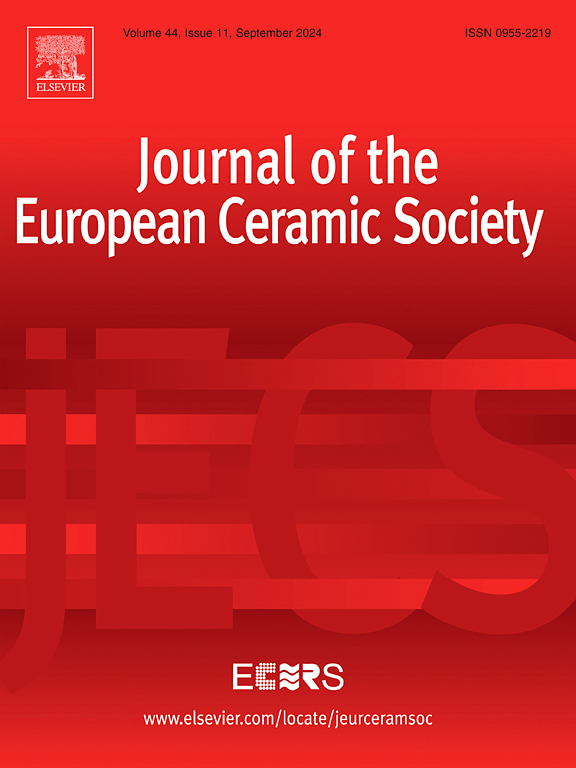通过掺杂高电负性Fe3+优化LLTO固体电解质晶体结构并提高其性能的研究
IF 5.8
2区 材料科学
Q1 MATERIALS SCIENCE, CERAMICS
Journal of The European Ceramic Society
Pub Date : 2025-03-15
DOI:10.1016/j.jeurceramsoc.2025.117368
引用次数: 0
摘要
钙钛矿型(Li0.33La0.56TiO3, LLTO)固体电解质具有优异的体导电性,是最有价值的固体电解质材料之一。然而,在目前的研究中,很少有关于电负性因素对LLTO晶体结构影响的研究。本文采用固相反应的方法,采用化学式Li0.33-xFexLa0.56TiO3(x = 0.01,0.03,0.05,0.07 mol)将LLTO中的Li+离子替换为强电负性的Fe3+离子来调整材料的晶格结构。研究了Fe3+对LLTO结构和性能的影响。结果表明,Fe3+的加入可以成功取代晶格中的Li+,有效提高LLTO的立方相含量、晶体完整性、晶粒尺寸均匀性和堆积密度,并进一步提高晶粒电导率。然而,随着Fe3+掺杂量的增加,会导致取代量过大,导致晶格中形成许多阳离子空位,不利于立方晶体的生长和完善。过量的Fe3+会导致晶粒生长过快,降低材料的晶粒尺寸均匀性和密度,从而降低材料的体积电导率。在本研究中,当样品掺杂0.01 mol Fe3+,在1220℃下烧结6 h时,获得了最佳的综合性能。c-LLTO含量达到93 %,堆积密度为4.75 g cm−3,体积电导率为1.42 mS cm−1,比未掺杂样品提高63.22 %。本研究表明,Fe3+的掺入显著提高了材料晶粒的体积导电性。本文章由计算机程序翻译,如有差异,请以英文原文为准。
Research on optimizing the crystal structure and enhancing the performance of LLTO solid electrolyte through doping with high-electronegativity Fe3+
The excellent bulk conductivity of the perovskite-type (Li0.33La0.56TiO3, LLTO) solid electrolyte makes it one of the most valuable solid electrolyte materials. However, in the current research, there are few studies examining how electronegativity factors influence the crystal structure of LLTO. In this paper, the solid phase reaction method was adopted to adjust the lattice structure of the material by the chemical formula Li0.33-xFexLa0.56TiO3(x = 0.01, 0.03,0.05, 0.07 mol) by substituting strong electronegativity Fe3+ ions for Li+ ions in LLTO. The effects of Fe3+ on the structure and properties of LLTO were studied. The results show that the addition of Fe3+ can successfully replace Li+ in the lattice, effectively improve the cubic phase content, crystal integrity, grain size uniformity and bulk density of LLTO, and further improve the grain conductance. However, increasing the doping amount of Fe3+ results in excessive unequal substitution, facilitating the formation of many cation vacancies in the lattice which is detrimental to the growth and perfection of cubic crystals. Also, excess Fe3+ causes exaggerated grain growth, reduction of grain size uniformity and the density of the material, thereby reducing the bulk conductance of the material. In this work, optimal comprehensive performance is achieved when the sample is doped with 0.01 mol of Fe3+ and sintered at 1220 °C for 6 h. The c-LLTO content reaches 93 %, bulk density of 4.75 g cm−3, and bulk conductivity of 1.42 mS cm−1 which is 63.22 % higher than that of the undoped sample. This study demonstrates that the incorporation of Fe3+ significantly enhances the bulk conductivity of the material's grains.
求助全文
通过发布文献求助,成功后即可免费获取论文全文。
去求助
来源期刊

Journal of The European Ceramic Society
工程技术-材料科学:硅酸盐
CiteScore
10.70
自引率
12.30%
发文量
863
审稿时长
35 days
期刊介绍:
The Journal of the European Ceramic Society publishes the results of original research and reviews relating to ceramic materials. Papers of either an experimental or theoretical character will be welcomed on a fully international basis. The emphasis is on novel generic science concerning the relationships between processing, microstructure and properties of polycrystalline ceramics consolidated at high temperature. Papers may relate to any of the conventional categories of ceramic: structural, functional, traditional or composite. The central objective is to sustain a high standard of research quality by means of appropriate reviewing procedures.
 求助内容:
求助内容: 应助结果提醒方式:
应助结果提醒方式:


